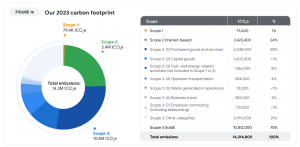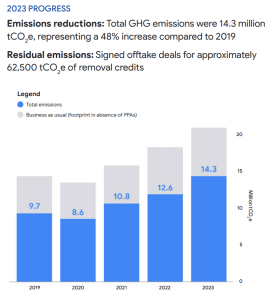Alphabet, Google’s parent company, reported a 14% year-over-year revenue increase, driven by search and cloud services, with cloud revenues surpassing $10 billion and achieving $1 billion in operating profit for the first time. Financial gains are increasing but so is Google’s carbon footprint.
Financial Highs, Environmental Lows
Google’s Way to Net Zero Carbon
Google is committed to accelerating the transition to a net zero future and has taken significant steps over the past two decades to minimize GHG emissions. In 2021, the company set an ambitious goal to achieve net zero emissions across all operations and its value chain by 2030. This goal is being pursued through two key strategies:
- Reducing Emissions: Google focuses on reducing emissions across its operations and value chain, including advancing 24/7 carbon-free energy (CFE).
- Addressing Residual Emissions: After reducing emissions, the company addresses any residual emissions with carbon removal initiatives.
The tech company’s net zero goal is designed not just for the company but also to help accelerate global decarbonization. To ensure maximum impact, the company regularly evaluates its plan to ensure it is rigorous, science-based, and realistic in light of evolving challenges and standards.
The company is also engaged in advocacy efforts, exploring data center innovations, accelerating global grid decarbonization, and advocating for GHG Protocol reform to drive systemic change.
2023 Carbon Footprint Rises
- Target: Reduce 50% of our combined Scope 1, 2 (market-based), and 3 absolute GHG emissions by 2030, 102 and invest in nature-based and technology-based carbon removal solutions to neutralize our remaining emissions

In 2023, Google’s total GHG emissions were 14.3 million tCO2e, representing a 13% year-over-year increase and a 48% increase compared to the 2019 target base year.

This increase was primarily due to higher data center energy consumption and supply chain emissions. As Google further integrates AI into its products, reducing emissions may become more challenging due to the increased energy demands from the greater intensity of AI computing and the emissions associated with the expected growth in technical infrastructure investment.
Google Carbon Lens’ Focus: Carbon Removal Credits
Google halted buying cheap carbon offsets that backed its carbon neutrality claim. As mentioned earlier, the tech giant is now focusing on investing in and advancing carbon removal solutions.
To advance carbon removal technologies, Google addresses key challenges facing these solutions. The company committed $200 million to Frontier, an initiative designed to accelerate carbon removal technologies by ensuring future demand. It partners with Charm Industrial, CarbonCapture, and Lithos Carbon.
Moreover, in March 2024, Google announced it would match the U.S. Department of Energy’s Carbon Dioxide Removal Purchase program dollar for dollar, committing to purchase at least $35 million in carbon removal credits over the next year.
Carbon-Free Energy Every Hour, Every Day
One big source of its carbon emissions which Google has direct control over is Scope 2. The tech firm’s primary approach to reducing Scope 2 emissions is through the procurement of carbon-free energy.
In 2020, Google set a goal to operate on 24/7 carbon-free energy (CFE)—every hour of every day on every grid where it operates—by 2030. This goal is being pursued through three main initiatives: purchasing carbon-free energy, accelerating new and improved technologies, and transforming the energy system through policy, partnerships, and advocacy.
The company buys electricity directly from new clean energy projects through various methods depending on the market, including:
- Contracting directly via long-term power purchase agreements (PPAs).
- Working with utilities or developers to buy and deliver carbon-free energy.
- Structuring energy supply contracts with energy providers through the CFE Manager model.
- Making targeted investments in renewable energy to enable additional projects on the grids where it operates.
From 2010 to 2023, Google signed more than 115 agreements to purchase over 14 GW of clean energy generation capacity—the equivalent of more than 36 million solar panels. Through these agreements, Google estimates it will spend more than $16 billion to purchase clean energy through 2040.
In 2023, Google signed contracts to purchase approximately 4 GW of clean energy generation capacity—more than in any prior year. These contracts included clean energy deals in North America, Europe, and Asia Pacific.
In early 2024, Google announced new PPAs—including its largest offshore wind projects to date—that will bring 700 MW of clean energy generation capacity to European grids.
Google’s commitment to achieving net zero emissions by 2030 involves a comprehensive strategy of reducing emissions, investing in carbon removal, and pursuing 24/7 carbon-free energy. Despite challenges like increased energy demands from AI, Google’s innovative approaches and significant investments are driving progress towards a greener digital future.


